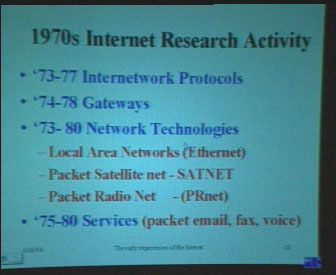

Vietnamin War ends, Helsinki CSCE conference
 Video: MPEG-1 file (17MB) Professor Peter Kirstein looks back at network research in the 1970s (in English) |
The predecessors of Internet electronic mail are introduced into the ARPANET in 1972. Networks developed for remote access to computers thus become a channel for human communication. The early counterparts to e-mail were generally only discussion systems internal to mainframe systems. The rudiments of many other future services were studied at this time. During the 1970s, research on the ARPANET is carried out in the USA. This produces TCP/IP, the basis of the Internet. In Europe, network research did not really evolve into true network services, partly as a result of the policies adopted by telecom monopolies. Only a few laboratories in Norway and the UK had links to American networks. |
In 1970, the Bank of Finland bought a Univac 1108 computer for 11.5 million Marks for the DataSITRA project. This was installed at the State Computer Centre (VTKK), from where it could be remotely accessed by telecommunications links. By the end of 1971, the universities have 1200 and 2400 bit/s leased lines to this computer from DCT2000 remote batch-processing terminals fitted with line printers and punch-card equipment. The decade's most important data storage medium, apart from large reels of magnetic tape, were punch cards for mainframe computers and paper tape for minicomputers. These were generally punched in advance, ready for running as a batch. It often took days to correct a single typing error. Links from interactive terminals became common towards the end of the decade, and packet-switching networks such as Telenet (1974), Scannet (1976) and Tymnet (1977) were set up, particularly for remote-terminal access to databases. |
|
The Finnish Telmac-1800 microcomputer, sold as an assembly kit (Photo and computer: Harri K. Salminen). |
Microcomputers begin to be popular, initially mostly in the form of
kits intended for enthusiasts and industry. In 1977, the ready-made
|
Video: Internet, Web, What's Next conference, CERN, Geneve, 26.6.1998 (2 Mbit/s MPEG-1)